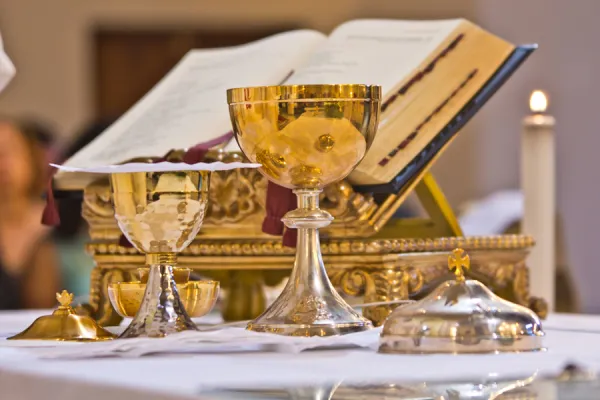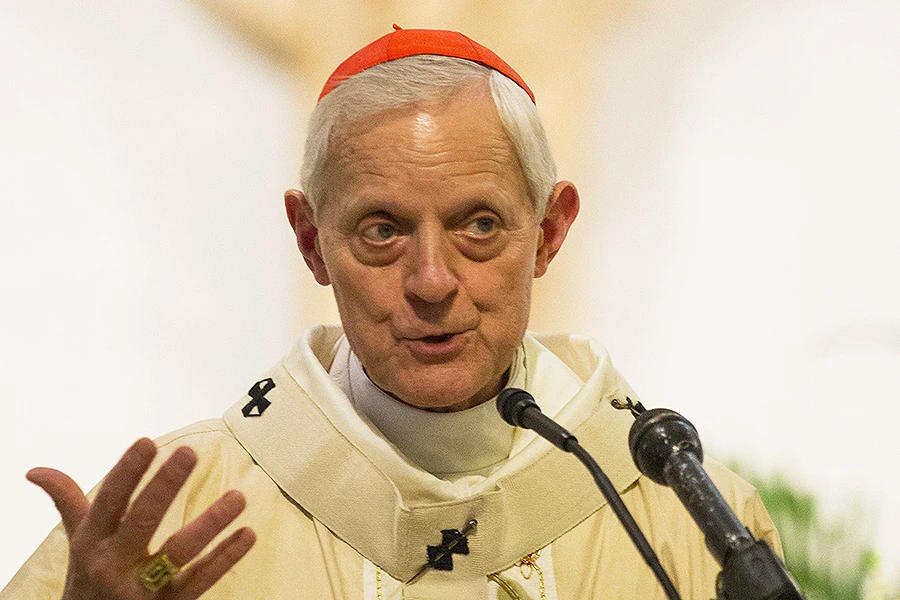
Portland, Ore., Aug 14, 2019 / 04:00 pm (CNA).- Parishioners of St. Francis of Assisi Parish in the Archdiocese of Portland staged a protest against their pastor during a June 30 Mass.
The Oregonian uploaded a video of the protests Aug. 11. The video shows elderly parishioners dressed in white, carrying signs into the assembly during the Eucharistic consecration, and attempting to shout down the pastor, Fr. George Kuforiji, during the Mass. Other parishioners are shown looking visibly uncomfortable at the disturbance.
The protests reportedly concern Fr. Kuforiji’s decision to remove unauthorised changes to the liturgy which had become common in the parish over previous years, and to take down a sign at the entrance to the church saying “Immigrants & Refugees welcome.”
Fr. Kuforiji, himself a Nigerian immigrant who was ordained in 2015, was installed as pastor of St. Francis of Assisi in 2018.
Prior to his arrival, The Oregonian reported, St. Francis was known for “progressive liturgy” that “embraced folk music” during Mass.
After arriving at the parish, Kuforiji reportedly insisted on using only Church-approved liturgical texts during the Mass. The texts refer to God as “He,” “Lord,” or “King,” instead of the gender neutral terms “God,” and “Creator” that had become customary replacements during parish liturgies.
Kuforiji also stopped the practice of reading a “community commitment” after the recitation of the Nicene Creed.
The video shows protesters shouting their own intercessory prayers over the pastor’s voice, and reciting the community commitment during Mass as a form of protest against Fr. Kuforiji’s changes. Some parishioners have also reportedly refused to refuse to kneel during the Eucharistic consecration, in defiance of a recent instruction from Portland Archbishop Alexander Sample.
The protests began in late June, when some of the parish’s handmade vestments were found in a trailer slated for the dump. According to The Oregonian, Fr. Kuforiji insisted that he had not intended to throw away the rainbow-bordered chasuble and other liturgical garb, but had intended that the vestments be placed in a storage box.
A parishioner, Albert Alter, found the vestments and accused Kuforiji of “trying to destroy the parish.”
“I don’t know anyone that would come to a parish and go to the vestment closet and take all the vestments, still on hangers, and throw them into a trailer without somebody of authority having instructed them to do so,” Alter told The Oregonian.
“We have been wanting real dialogue. I said that we are being abused. We are being abused in the Catholic Church by this priest, and by this archbishop,” said Melinda Pittman, a 30-year parishioner of St. Francis, filmed speaking at the lectern after Mass on June 30.
In the video, cries of “yes,” along with the sound of shaking maracas, are heard from the pews after Pittman states the parish is being “abused” by the priest.
At the end of the speeches following Mass on June 30, a group of parishioners confronted the priest, who can be heard saying “we are reverencing God.”
The demonstrators then linked arms and sang “We Shall Overcome,” a Gospel song typically associated with the civil rights movement in the U.S., in protest of the African-born priest.
Another attendee supporting Fr. Kuforiji as a “holy priest,” was told “you don’t belong here” by others in the assembly.
Tom Hogan, a 76-year-old parishioner of St. Francis and one of the few remaining parishioners who attended its grade school, told The Oregonian that many of the liturgical deviations at the parish were instituted by former pastor Fr. Donald Durand.
Durand’s priestly faculties were withdrawn shortly after his retirement from active ministry in 2001. He has been accused of molesting more than a dozen preteen and teenage boys, some of whom were students at St. Francis Assisi School, and numerous lawsuits against him have reportedly been settled.
Durand was pastor at St. Francis from 1970 until 1983. He has denied all allegations of misconduct.
A statement from the Archdiocese of Portland said that the archdiocese is “happy to be working with Fr. George Kuforiji, Pastor of St. Francis Parish, to revitalize the parish so that it is able to better serve the growing population in the area as well as future generations of Catholics in Portland.”
The Oregonian also reported that since late June, Mass attendance at St. Francis has dropped, and the entire choir quit and that Catholic Charities of Oregon took control of the parish’s St. Francis Dining Hall, which feeds local homeless people, in early August for a temporary, three-month period.
“The Archdiocese of Portland is excited to work with the City of Portland, Catholic Charities of Oregon and the local community to re-establish St. Francis Dining Hall as a beacon of light and mercy serving those most in need,” the archdiocesan statement said.
If you value the news and views Catholic World Report provides, please consider donating to support our efforts. Your contribution will help us continue to make CWR available to all readers worldwide for free, without a subscription. Thank you for your generosity!
Click here for more information on donating to CWR. Click here to sign up for our newsletter.




We read from the surely-scripted Melinda Pittman, a 30-year parishioner of St. Francis [Parish]: “I said that we are being abused. We are being abused in the [2000-year young!] Catholic Church by this priest, and by this archbishop.”
Sounds like she’s sorta right (or Left?) about the hackneyed “abuse” thingy. BUT the real abuse has been going on for probably decades, and now finally is being lifted. John Paul II’s New Evangelization of the moribund West is finally showing results! And from faraway Africa!
As in another script: Dr. Zhivago, in the darkest night of the “ice castle” on the far side of the Urals, and against the howling of other wolves, protested thusly into the frozen and moonlit wasteland: “It’s a good time to be alive!”
Fr. Kuforiji—-who is guilty NOT of changes but of UNchanges—-is from Nigeria, a land of greater strife than anything in the Rose City. Within the context of interreligious complexity and from the Muslim Hadith, we find this cross-cultural assessment or the latest Portland tantrum: “The dogs bark, but the caravan moves on.”
Father Kuforiji seems like a faithful priest. I hope his bishop supports him. Once I joined a parish that had just been assigned a new priest. He was a perfectly fine priest. I witnessed them run this pastor off and then high five each other. Needless to say, I left that parish and have never returned. After they ran their priest off, they were not assigned a pastor in residence any longer and had to take a priest that came in from a distance.
Ah. So, by their own left-wing standards, the protesting parishioners are racists.
Father “Kuforiji reportedly insisted on using only Church-approved liturgical texts during the Mass.”
Oh, the horror, the horror!
“The video shows protesters shouting their own intercessory prayers over the pastor’s voice, and reciting the community commitment during Mass as a form of protest against Fr. Kuforiji’s changes. Some parishioners have also reportedly refused to refuse to kneel during the Eucharistic consecration, in defiance of a recent instruction from Portland Archbishop Alexander Sample.”
I can imagine what they’re shouting: “Non serviam!”
“The Oregonian also reported that since late June, Mass attendance at St. Francis has dropped,”
As the faux-Catholics stomped out?
“and the entire choir quit”
And took their guitars and maracas with them, presumably. Small loss.
Poor Fr. Kuforiji. I hope he can stand his ground. This parish has strayed and resists being brought back into the fold. Prayers of exorcism are in order. I wish I were kidding.
Sacrosanctum Concilium (22 §3) states clearly that it belongs to the Holy See to establish the liturgical books and that “therefore, no other person, not even if he is a priest, may on his own add, remove, or change anything in the liturgy”. The Catechism of the Catholic Church repeats the principle that “no sacramental rite may be modified or manipulated at the will of the minister or the community” (1125). There is no easement allowing the abuses that these people are advocating, not in the General Instruction of the Roman Missal, the Sacramentary, the Code of Canon Law, any liturgical instructions or encyclicals, nor the archives of Notitiae.
The only explanation is that the protestors haven’t got the faintest notion of what the Church is. The problem is that the Archdiocese of Portland doesn’t think to remind those people of that rule, plainly. And that it doesn’t bother to instruct people who want to be Catholic Christians about exactly what that means.
I take issue with the headline, which suggest that it’s somehow the priest’s personal preferences or “policies” which caused the protests. Maybe the dissident parishioners think so, but in truth he’s only returning the church to authentic liturgy — the Church’s, not his. I notice some of the protesters had an issue with kneeling for the Consecration also. That speaks volumes.
Also says a lot that the person who defended the priest was attacked with “you don’t belong here.” So much for peace, love, inclusion, and tolerance — qualities the dissidents would no doubt claim for themselves, because, after all, they’re “progressive.”
The situation reminds me of a parish near me (not my home parish) where the longtime, much-beloved pastor died. A priest who was pastor of a nearby church was assigned to serve as administrator and say Mass. He was also given the unpleasant but necessary task of preparing that community to merge with other parishes. I had never seen such petty, mean-spirited mistreatment of a priest until then. Case in point: The poor guy chose a more traditional hymn to sing at the recessional of a daily Mass. He wasn’t all the way down the aisle when a woman called out, “Anyone remember this goldie oldie?” and started loudly singing a “hymn” I haven’t heard (thank God) since I was in grade school when VII fever was at its worst. Several people very loudly joined in. It was obviously intended as a protest and a rebuke of this priest who didn’t “belong,” coming from folks who evidently thought they owned the parish. The parish closed some months later; the people who mistreated the priest have gone on to make pests of themselves at other parishes, no doubt.
We, too, had a priest who was run out of the parish by a gossipy, critical secretary who seemed to aspire to the title of sergeant-major. Her mouth was an open window to all the business of the parish, whether it was confidential or not. Eventually, the priest had had enough and fired her. It was then that the “owners” of the parish stepped up and began to call for the bishop to remove the pastor, even calling for a “town meeting”, which became a forum of petty objections, with the bishop in attendance. It was not long that the pastor was transferred. This is a very good priest, actually quite a Catholic scholar who did everything he could to fulfill his vocation. So often parishioners forget the church is not a democracy…….. They want it “their way”
The bishops and priests upholding the teachings of Christ are being persecuted. We need to pray for their courage and perseverance. We also need to write to them to show our support for what they are doing.
http://www.archdpdx.org/